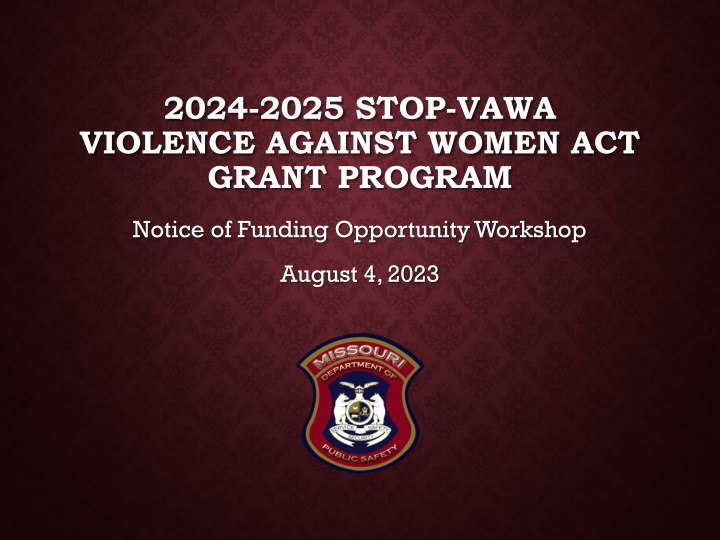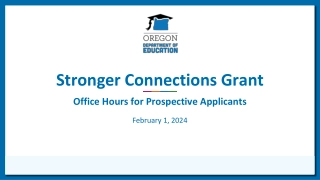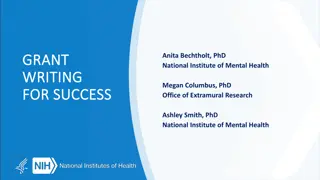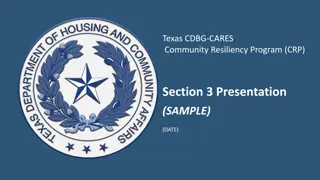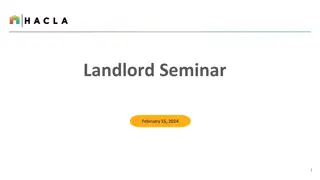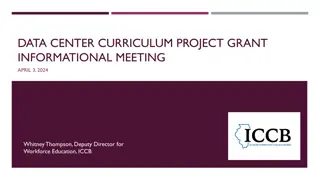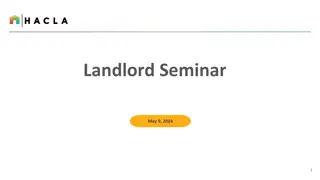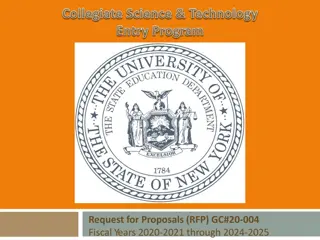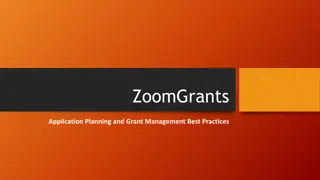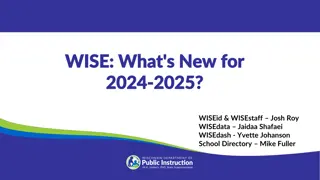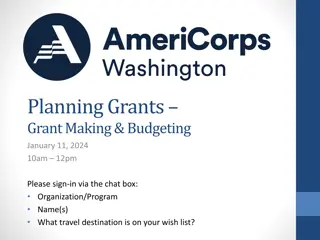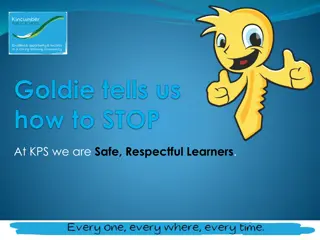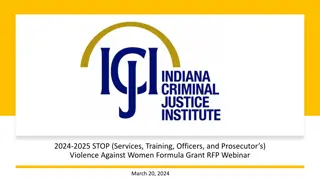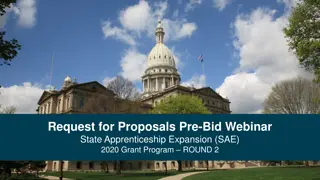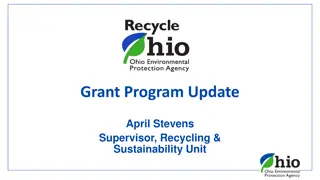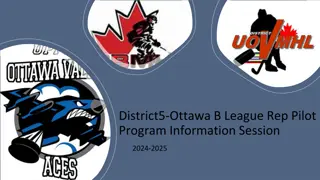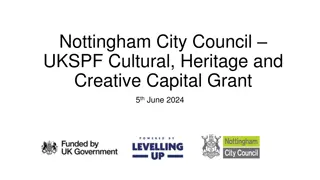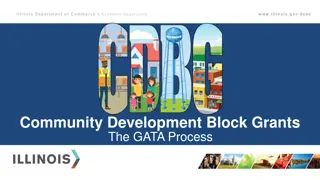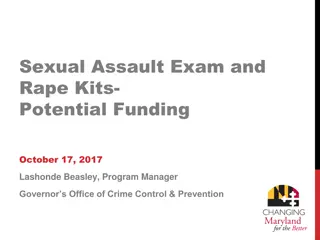STOP VAWA Grant Program 2024-2025
The STOP Violence Against Women Act (VAWA) Grant Program for 2024-2025 aims to combat sexual assault, domestic violence, dating violence, and stalking. The program focuses on training criminal justice personnel, developing specialized units, and implementing policies to prevent and respond to violent crimes against women. Deadlines, staff details, and the primary purpose of the STOP VAWA program are highlighted in this notice.
Download Presentation

Please find below an Image/Link to download the presentation.
The content on the website is provided AS IS for your information and personal use only. It may not be sold, licensed, or shared on other websites without obtaining consent from the author.If you encounter any issues during the download, it is possible that the publisher has removed the file from their server.
You are allowed to download the files provided on this website for personal or commercial use, subject to the condition that they are used lawfully. All files are the property of their respective owners.
The content on the website is provided AS IS for your information and personal use only. It may not be sold, licensed, or shared on other websites without obtaining consent from the author.
E N D
Presentation Transcript
2024-2025 STOP-VAWA VIOLENCE AGAINST WOMEN ACT GRANT PROGRAM Notice of Funding Opportunity Workshop August 4, 2023
CRIME VICTIM SERVICES UNIT PROGRAM STAFF Grant Staff: Tina Utley, Grants Specialist Veronica Giedd, Grants Officer Additional Staff: Connie Berhorst, Program Manager Michelle Parks, Senior Program Specialist Chris Yeager, Senior Program Specialist
2024-2025 STOP VAWA CONTRACT PERIOD January 1, 2024 through December 31, 2025 (Please note, this is a 2 year contract!)
DEADLINES WebGrants Registration for NEW organizations: Friday September 1, 2023 at 5:00 p.m. New organizations must be registered to access WebGrants New registered users may be added by the organization at any time Applications must be submitted by: Friday September 15, 2023 at 5:00 p.m. All information/documents must be submitted with the final application via WebGrants Missing or late information/documents will not be accepted
WHAT IS STOP VAWA? STOP Services * Training * Officers * Prosecutors VAWA Violence Against Women Act The STOP VAWA Program was authorized under the Violence Against Women Act of 1994 (VAWA) and reauthorized and amended by the Violence Against Women Act of 2005 (VAWA 2005) and the Violence Against Women Act of 2013 (VAWA 2013)
PRIMARY PURPOSE OF STOP To encourage the development and strengthening of effective responses to sexual assault, domestic violence, dating violence, and stalking
STOP PURPOSE AREAS Training criminal justice personnel to more effectively identify and respond to violent crimes against women Developing, training, or expanding criminal justice units specifically targeting violent crimes against women Developing and implementing more effective criminal justice policies, protocols, orders, and services specifically devoted to preventing, identifying, and responding to violent crimes against women, as well as the appropriate treatment of victims.
STOP PURPOSE AREAS (CONT.) Developing, installing, or expanding data collection and communication systems for criminal justice agencies Developing, enlarging, or strengthening victim services and legal assistance programs and developing or improving delivery of victim services to underserved populations, Supporting multidisciplinary efforts to coordinate the response of agencies to violent crimes against women Training of sexual assault forensic medical examiner personnel
STOP PURPOSE AREAS (CONT.) Developing, enlarging, or strengthening programs to assist agencies to address the needs of older and disabled women who are victims of domestic violence, dating violence, stalking, and sexual assault Providing assistance to victims of domestic violence and sexual assault in immigration matters Maintaining core victim services and criminal justice initiatives, while supporting complementary new initiatives and emergency services Supporting Jessica Gonzales Victim Assistants Law enforcement advocate to improve enforcement of PO Providing Crystal Judson Domestic Violence Advocates Funding that pertains to providing services to victims of domestic violence committed by law enforcement personnel
STOP PURPOSE AREAS (CONT) Developing and promoting state, local, or tribal legislation and policies that enhance best practices for responding to domestic violence, dating violence, sexual assault, and stalking Developing, implementing, or enhancing Sexual Assault Response Teams Developing/strengthening policies, protocols, best practices, and training for law enforcement agencies and prosecutors relating to the investigation/prosecution of sexual assault cases and the appropriate treatment of victims Developing, enlarging, or strengthening programs addressing sexual assault in correctional or detention settings
STOP PURPOSE AREAS (CONT.) Identifying and conducting inventories of backlogs of sexual assault evidence collection kits Developing, enlarging, or strengthening programs and projects to provide services to victims whose ability to access traditional services and responses is affected by their sexual orientation or gender identity Developing, enhancing, or strengthening prevention and educational programming Not more than 5% of the amount allocated to a state may be used for this purpose
STATUTORY FUND ALLOCATION Funds must be distributed to specific funding categories: Law Enforcement 25% Prosecution 25% Courts 5% Discretionary 15% Victim Services 30% Culturally Specific 10% of the 30% 20% of the total amount granted shall be allocated to projects in two, or more, allocations that meaningfully address sexual assault
ELIGIBLE APPLICANTS Public Agencies Certification of consultation with victim service programs required This is addressed in the application includes how you consulted and worked with victim service programs in the process of developing your application Non-profit Agencies Must submit proof of non-profit 501(c)(3) status
COMPLIANCE ELIGIBILITY Comply with Federal Rules which regulate grant Comply with State Criteria Maintain Civil Rights information Comply with Non-Discrimination requirements Comply with Federal Fair Labor Standards Act Provide access to services for persons with Limited English Proficiency (LEP)
COMPLIANCE ELIGIBILITY CONT. Forensic Exams Cannot require participation in criminal justice system, or cooperation with law enforcement Polygraph Cannot require of a sexual assault victim as a condition for proceeding with criminal investigation
COMPLIANCE ELIGIBILITY CONT. Victim Eligibility Eligibility for services not dependent on immigration status Confidentiality May not release identifying information without written release, unless required by statute or court order Service Standards Agencies that primarily serve DV or SV victims must comply with the applicable Missouri Coalition Against Domestic & Sexual Violence (MOCADSV) Service Standards and Guidelines Agencies that do not primarily serve DV or SV victims, must comply with the MoCVSU Standards and Guidelines
ALLOWABLE SERVICES Personnel, training, technical assistance, data collection, evaluation, and equipment costs to enhance the apprehension, prosecution, and adjudication of persons committing violent crimes against women Enhance services that meet the needs of women victimized by violence
ALLOWABLE SERVICES (CONT) Civil Justice Assistance Legal assistance to victims attempting to obtain civil protection orders may be supported with STOP funds because it is consistent with the overall intent of the statute Children s Services May support complementary services for victims families Batterer s Intervention Programs BIP may be supported if the intervention is part of a graduated range of sanctions, and uses the coercive power of the criminal justice system to hold abusers accountable
ALLOWABLE COSTS Personnel/Personnel Benefits Travel Equipment (necessary in provision of services) Supplies/Operations (necessary in provision of services) Contractual Expenses Indirect Costs
UNALLOWABLE COSTS/SERVICES Activities exclusively related to Crime Prevention Large Items of Equipment Bonuses or Commissions Lobbying Physical Modifications / Renovations to Buildings Fundraising Construction Costs Professional Dues, Subscriptions, Memberships Alcoholic Beverages Automobiles Entertainment Immigration Fees Property Loss Capital Improvements Research Cost of sending individual victims to conferences Real Estate Acquisition
SUPPLANTING Federal funds must be used to supplement existing State and local funds for program activities and must not supplant those funds that have been appropriated for the same purpose Supplanting will be reviewed during the application process, post-award monitoring, and audit Supplanting applies to non-profit agencies, as well as government agencies Supplanting must be addressed in the applicable budget justification sections
MATCH Applies to public agencies only 25% of total project cost must be from non-federal sources Cash or In-Kind Local match is restricted to same use as federal funds Records must be maintained for matching funds
ELIGIBLE IN-KIND MATCH Volunteer Time Direct service to victims $18.00/hour Volunteers cannot be employees Non-Monetary contributions/donations Donated Equipment Fair Market Value Space Fair Rental Value as determined by appraisal or realtor Cannot donate space to self
ELIGIBLE CASH MATCH Source of match must be provided Attributable to line items in grant budget Salary Fringe benefits Mileage Etc.
NOTICE OF FUNDING OPPORTUNITY PACKET The following items are addressed in detail in the Notice of Funding Opportunity (NOFO) Packet Introduction to STOP VAWA Statutory Purpose Areas Program Priorities Definitions Eligibility Requirements Eligible Organizations Allowable Services, Activities, and Costs Unallowable Services, Activities, and Costs Completing and submitting the Application
APPLICATION PROCESS & REVIEW Proposals submitted electronically via DPS WebGrants Competitive bid process Evaluated by a Review Panel Review Panel consists of: Individuals from the Department of Public Safety Individuals from outside the Department who do not have a personal financial interest in this program Review panels change for each grant process, and from grant cycle to grant cycle Final approval provided by the Director of the Missouri Department of Public Safety (MoDPS)
GRANT APPLICATION INSTRUCTIONS Applications must be submitted electronically using the Missouri Department of Public Safety WebGrants System https://dpsgrants.dps.mo.gov/index.do The deadline to submit applications is Friday September 15, 2023 at 5:00 p.m.
WEBGRANTS REQUIRED INFORMATION Acquire a UEI (Unique Entity ID) Number Applicants for federal grants and cooperative agreements are required to have a UEI Number Obtaining a UEI number is a free, one-time activity If your organization does not know its UEI number or needs to register for one, visit https://sam.gov
WEBGRANTS REQUIRED INFORMATION Ensure your SAM CAGE code is up to date This must be updated in sam.gov annually You must notify our office when updated so that we may enter the new date in WebGrants
REGISTERING WITH WEBGRANTS If the organization you are applying for is new to WebGrants, you will need to register to use the system: https://dpsgrants.dps.mo.gov NEW organizations must register no later than September 1, 2023 by 5:00 p.m. Each applicant agency should designate one individual for the purposes of registering and assigning users
THE APPLICATION Comprised of electronic forms Instructions are provided for each form Please follow the on-screen instructions provided
GENERAL INFORMATION FORM Provides general information about the agency and the project: Project Title Should be brief, yet unique to the project 2024-25 VAWA Project is not unique to an agency Primary Contact This is the person who will be contacted regarding the application during the award process Organization
CONTACT INFORMATION FORM Lists the individuals who are responsible for the agency/project: Authorized Official Project Director Person overseeing project May not be the same person as the Authorized Official Fiscal Officer Project Contact Person Non-Profit Chairperson (if applicable)
CONTACT INFORMATION FORM Law City County Government Nonprofit Agency Enforcement Agency Government Board City Mayor or Administrator/ County Commissioner Presiding Commissioner/ Administrator President/Chair or person able to enter agency into a contract Authorized Official Mayor or City Administrator Person overseeing project Person overseeing project Person overseeing project Project Director Police Chief/Sheriff City Treasurer or Comptroller County Treasurer or Comptroller City/County Treasurer or Comptroller Fiscal Officer Board Treasurer / CFO
PROJECT SUMMARY FORM Provides general information about the agency/project: Application Type Current Contract Number (if agency is a current recipient of STOP VAWA funds) Program Category Project Type Geographical Area to be Served Brief Summary Should be no more than a few sentences, based upon the project you are requesting Program Income
STATEMENT OF THE PROBLEM FORM Please note that this form has been updated to include questions with individual text boxes Defines the problem the project will attempt to impact Addresses need for grant funds to support the proposed project Presents quantitative evidence to demonstrate the problem and the need for grant funds Local crime statistics from law enforcement Must be current Population & demographic information Agency Statistics
TYPE OF PROGRAM FORM Briefly describes your agency Addresses the services this project will provide What services will be provided Who will provide the services Who will benefit from the services How services are accessed Addresses how the agency is in compliance with either MoCVSU Standards or MOCADSV Standards Brief examples should be used to demonstrate compliance with Standards
COORDINATION OF SERVICES Explains how your agency coordinates activities with: Other service providers Law Enforcement Prosecuting Attorney offices Courts
CONSULTATION WITH VICTIM SERVICES Prosecution, Law Enforcement, and Court applicants are required to consult with victim service programs during the course of developing their grant application Explain how you consulted with victim service agencies to develop your application Do not simply state that VS agencies were consulted!
NUMBER OF VICTIMS TO BE SERVED Indicate the anticipated number of victims to be served by this project by this 2 year project Do not include the total number of victims served by your agency; only the number that will be served specifically by this project Provide the basis for this estimate (i.e. prior years numbers) Break out the number of men, women, and children separately Numbers should match the VAWA Data Form If serving multiple counties, please provide a breakdown by county
GOAL AND MEASURABLE OBJECTIVES FORM In efforts to improve the evaluation of program funding through VAWA, all sub-recipients will implement the same goal into their project Goal: To hold batterers accountable and strengthen services to victims of domestic violence, sexual violence, dating violence and stalking, applies to: courts; prosecutorial agencies; law enforcement; culturally and linguistically specific projects and victim centered project Objectives: The objectives are provided in a drop down box and are based on type of service provided
EVALUATION PROCEDURE FORM Describes the process(es) used to collect data and explains how the information is used to improve services Must tie back to the Goal and Objectives Lists the objectives and explains how the outcomes for each will be measured Attach a copy of blank evaluation tools/surveys in Required Attachments
REPORT OF SUCCESS FORM Current sub-recipients Must list the Goal and Objectives of the current contract and provide results to-date (i.e. 01/01/2022-08/31/2023) The outcomes should provide actual numbers, in addition to the percentages New projects do not address a Report of Success Put n/a in this section
BUDGET FORMS Lists funding requests for budget categories Each category assigned a section for justification
BUDGET FORMS Written Budget Justification narrative: Do not simply re-list the items you are requesting JUSTIFY the need and expense of each item in narrative format EXPLAIN why each cost is requested if an increase/new line item (i.e. current agency expense not funded through VAWA), explain how the agency has paid for the expense in the past, and why it is necessary for VAWA to assume this cost Supplanting DOES apply to non-profit agencies as well as government agencies If a brand new cost to the agency, as well as to VAWA, explain why the expense is necessary
BUDGET FORMS (CONT.) Personnel Minimum 10% grant funded may be requested Requests for less than 10% will not be considered Salary based on pay period (not monthly, unless paid monthly) If an increase is anticipated, each salary rate should be a separate line; provide effective dates in the Name field (ex: Jane Doe 01/01/2024; Jane Doe 01/01/2025) Justification: Provide work experience & education for personnel Provide reason for any requested increase (COLA, Merit, etc.) Include percentage or amount of increase and effective date
BUDGET FORMS (CONT.) Personnel Benefits Fringe benefits must be itemized and prorated according to percentage of time on grant Benefits based on a percentage of salary (i.e. FICA, pension, etc.) may be claimed on one line List total VAWA salary x rate x 100% 2023 taxable rate for unemployment is $10,500/year
BUDGET FORMS (CONT.) PRN/Overtime Staff in PRN positions work on an as needed basis PRN positions are budgeted positions; however, are considered temporary employment Consistent with temporary positions, staff in PRN positions are not eligible for most employment benefits Justification Explain the need for PRN/Overtime positions Provide names of the PRN/Overtime employees
BUDGET FORMS (CONT) Volunteer Match Automatically calculates at $18.00/hour Employees and Board Members are not considered volunteers Justification Discuss the specific activities/duties of volunteers to be used as match Allowable activities/duties are the same as those considered allowable for grant funded staff
BUDGET FORMS (CONT.) Travel/Training Mileage Maximum mileage allowance is $0.655/mile (State rate) or the applicant agency rate, whichever is less Meal & lodging per diem rates should be used to estimate costs https://oa.mo.gov/accounting/state-employees/travel-portal- information/state-meals-diem Miscellaneous training may be requested If awarded, prior approval must be sought at least 30 days in advance of the training Provide justification for any travel requested (e.g. who, what, when, where, why, and cost) Agency travel policy, including current mileage reimbursement rate, must be submitted with application if travel is requested
